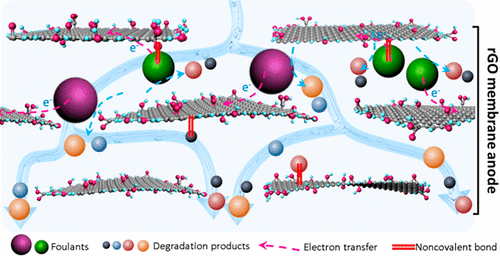当前位置:
X-MOL 学术
›
Environ. Sci. Technol. Lett.
›
论文详情
Our official English website, www.x-mol.net, welcomes your
feedback! (Note: you will need to create a separate account there.)
Electrochemical Cleaning of Fouled Laminar Graphene Membranes
Environmental Science & Technology Letters ( IF 8.9 ) Pub Date : 2020-08-20 , DOI: 10.1021/acs.estlett.0c00617 Gaoliang Wei 1 , Yongsheng Zhao 1 , Jun Dong 1 , Miao Gao 1 , Chao Li 2
Environmental Science & Technology Letters ( IF 8.9 ) Pub Date : 2020-08-20 , DOI: 10.1021/acs.estlett.0c00617 Gaoliang Wei 1 , Yongsheng Zhao 1 , Jun Dong 1 , Miao Gao 1 , Chao Li 2
Affiliation

|
Laminar graphene (including reduced graphene oxide (rGO)) membranes have recently received significant attention because of their potentially excellent permeability and selectivity; however, their fouling problem associated with the foulants blocked within graphene nanochannels has not been thoroughly investigated. This study confirms the blockage of molecules within the rGO membranes by investigating their rejection ratios at various membrane thicknesses and then presents an electrochemical in situ cleaning strategy (with the membrane as anode) aimed at oxidative decomposition of the foulant molecules. This method could restore the permeance (<3.0 L m–2 h–1 bar–1) after the filtration of the methyl blue solution to greater than 9.2 L m–2 h–1 bar–1 in 20 min at a voltage of 2.5 V without suspending the filtration process, resulting in a recovery ratio of greater than 94%. Such a high recovery ratio could still be achieved after six “fouling–cleaning” cycles. The process is energy efficient with only approximately 6.7 Wh consumed for 1 m2 of membrane area and a single cleaning. In addition, the electrochemical cleaning could largely avoid the damage of the membrane structure by preventing the formation of microbubbles, nanoparticles, and highly active hydroxyl radicals.
中文翻译:

电化学清洗结垢的层状石墨烯膜
层状石墨烯(包括氧化石墨烯(rGO)还原膜)由于其潜在的优异的渗透性和选择性而受到了广泛的关注。然而,它们与与石墨烯纳米通道内阻塞的结垢有关的结垢问题尚未得到彻底研究。这项研究通过研究rGO膜在各种膜厚度下的排斥率来确认分子的阻滞作用,然后提出了一种电化学原位清洗策略(以膜为阳极),旨在将污垢分子氧化分解。该方法可以在过滤甲基蓝溶液后恢复到大于9.2 L m –2的渗透率(<3.0 L m –2 h –1 bar –1)。在2.5 min的电压下,在20分钟内达到h –1 bar –1,而无需中断过滤过程,因此回收率大于94%。经过六个“污垢-清洁”循环后,仍然可以实现如此高的回收率。该过程具有能源效率,每1 m 2的膜面积仅消耗约6.7 Wh,并且只需进行一次清洁。另外,通过防止微气泡,纳米颗粒和高活性羟基自由基的形成,电化学清洁可以很大程度上避免膜结构的损坏。
更新日期:2020-10-13
中文翻译:

电化学清洗结垢的层状石墨烯膜
层状石墨烯(包括氧化石墨烯(rGO)还原膜)由于其潜在的优异的渗透性和选择性而受到了广泛的关注。然而,它们与与石墨烯纳米通道内阻塞的结垢有关的结垢问题尚未得到彻底研究。这项研究通过研究rGO膜在各种膜厚度下的排斥率来确认分子的阻滞作用,然后提出了一种电化学原位清洗策略(以膜为阳极),旨在将污垢分子氧化分解。该方法可以在过滤甲基蓝溶液后恢复到大于9.2 L m –2的渗透率(<3.0 L m –2 h –1 bar –1)。在2.5 min的电压下,在20分钟内达到h –1 bar –1,而无需中断过滤过程,因此回收率大于94%。经过六个“污垢-清洁”循环后,仍然可以实现如此高的回收率。该过程具有能源效率,每1 m 2的膜面积仅消耗约6.7 Wh,并且只需进行一次清洁。另外,通过防止微气泡,纳米颗粒和高活性羟基自由基的形成,电化学清洁可以很大程度上避免膜结构的损坏。











































 京公网安备 11010802027423号
京公网安备 11010802027423号